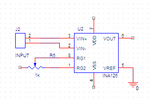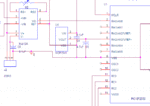denujith
Member level 5
Hi All,
I am building a thermometer interfacing a S-type thermocouple. Planning to use INA126 operational amplifier to amplify thermocouple output.
I assembled the circuit in a bred board and tested.
Here are my test results:
A voltage divider was used to generate input voltage in the range of miliivolts.
According to the datasheet, Gain:
G = 5 + 80kΩ/Rg
But my test results doesn't give me the theoretical Gain as specified in the datasheet. Then I removed the Rg and applied 1mV to the input. It produced fluctuating value in between 0.8V and 1.1V.
My hardware setup is as below:

Please let me know what can be the reason to deviate Gain from the intended values as mentioned in the spec.
Regards,
/Lakmal
I am building a thermometer interfacing a S-type thermocouple. Planning to use INA126 operational amplifier to amplify thermocouple output.
I assembled the circuit in a bred board and tested.
Here are my test results:
Code:
Rg/Ω = 258
In/mV Out/V
-----------------------
0 1.76
1 1.93
2 2.13
3 2.31
4 2.48
5 2.70
6 2.90
7 3.09
8 3.25
9 3.44
10 3.65
11 3.83
12 4.02
13 4.22
14 4.42
15 4.58A voltage divider was used to generate input voltage in the range of miliivolts.
According to the datasheet, Gain:
G = 5 + 80kΩ/Rg
But my test results doesn't give me the theoretical Gain as specified in the datasheet. Then I removed the Rg and applied 1mV to the input. It produced fluctuating value in between 0.8V and 1.1V.
My hardware setup is as below:

Please let me know what can be the reason to deviate Gain from the intended values as mentioned in the spec.
Regards,
/Lakmal
Last edited:




